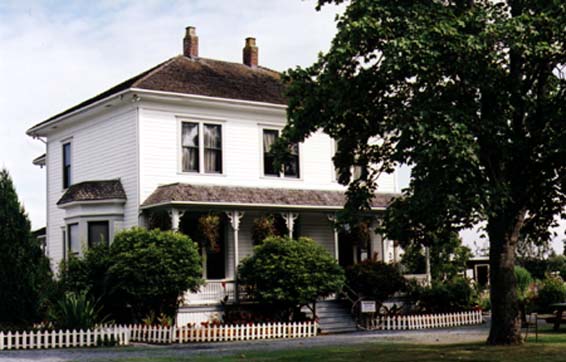London Farmhouse
 Photograph taken by:Denise Cook
Photograph taken by:Denise Cook
Photograph taken on:Sunday, September 24, 2000
General Information
Type of Resource: Building
Common Name:
Address: 6511 Dyke Road
Neighbourhood (Planning Area Name): Gilmore
Construction Date: 1898; Front Portion 1906
Current Owner: Municipal Government
Designated: Yes
Statement of Significance
Description of Site
The London Farmhouse is a two-storey home in the Edwardian Builder style, but with Craftsman influences. Its immediate context is the vestiges of an extensive farm operation, including dairy, grain fields, orchard, vegetable gardens and flower gardens.
Statement of Values
One of the earliest farm sites in the South Arm, the London Farmhouse has heritage value for its historic association with the London family, an important South Arm family which established London’s Landing, a small settlement on the river with a wharf from which farm products were shipped and supplies received. This wharf later became a ferry dock with links to other parts of the Lower Mainland.
London Farm also has social value, with a connection to the Presbyterian church which had a preaching station located at London’s Landing. The London Farmhouse has aesthetic importance as an excellent example of a late-Victorian-era farmhouse, and is situated among the remnants of the original significant farm operation and its extensive gardens, outbuildings, and other associated landscape features.
London Farm is a municipally designated heritage site.
Character Defining Elements
Key elements that define the heritage character of the site include:
· The early Edwardian Builder style of the entire house, which includes elements such as the vertical massing, hipped roof, and front verandah.
· The Craftsman influences of the house design, including a gabled dormer windows , open railing on the verandah, and turned columns with decorative brackets supporting the verandah roof.
· The associated rural landscape context of the site, including gardens, outbuildings and agricultural fields.
History
The original owners of the farm, William and Thomas McNeeley, were Lulu Island’s first farmers, arriving in 1865. Charles and Edwin London were born in Brant County, Ontario. Arriving in Richmond in 1880, they purchased a 200-acre portion of the McNeeley’s farm. The first house was built on the site in 1881 and has since been demolished. Although no documentation exists to exactly pinpoint the construction dates, evidence indicates that the present building was constructed in two parts. The north section was built between the marriage of Charles in 1888 (to Henrietta Dalziel) and the birth of a daughter Lucy in 1898, and the south, or front, section was constructed in 1906. Charles London also built a small wharf from which he shipped farm products and received supplies; this became known as London’s landing.
The London’s farm soon became the centre of much community activity. Before the South Arm Presbyterian Church was built, Presbyterians living on the south side of Lulu Island in the early 1900’s had traditionally gathered their congregation at a preaching station at London’s Landing, rather than attending the Presbyterian church on Sea Island. There is the possibility that services were held in the London farmhouse as well. Both Charles and William were influential in the local community and contributed to its development; William London served as a city councillor from 1883 to 1887. In 1921, H. Howse purchased the farm and married Lucy London. Mr. Howse sold the farm in 1948.
The Municipality of Richmond purchased the house and 41/2 acre site in 1978, and designated it a municipal heritage site. In 1980, the Richmond Historical Society agreed to restore and operate the house and immediate surroundings as a heritage property. Currently, the house is furnished and open to the public, with afternoon tea being served.
Architectural Significance
Architectural Style
Early Farmhouse
Building Type
Agricultural – Farm or Ranch House
Design Features
The 2-storey house is T-shaped in plan, with an inviting full front verandah and two side porches in the angles formed by the T. It sits on a foundation of pier blocks. The house is clad in horizontal drop-siding with cornerboards and is painted white. The windows are double hung wooden sash; during the restoration exact copies were obtained as replacements. There is a bay window on the west side of the house with a mansard roof. The main roof is hipped and its material is cedar shingle, with fish-scale shingles on the roof of the verandah and bay window. The verandah is supported by six square columns with decorative brackets, and has a decorated open railing. The house has three internal chimneys. The interior staircase in the original north part of the house has not been restored.
Construction Method
The house is of wood frame construction, but is unusual for its use of a balloon framing structural system, in which the supporting wooden studs run the full height of the two storeys.
Landscape Significance
Landscape Element
Vegetation, Garden and Farm. The Farmhouse has recent foundation planting of broad-leaved evergreen and coniferous shrubs. Two large maple trees flank the front walkway and there are other significant deciduous trees on the front lawn. Earlier photographs show a row of deciduous trees at the north side (rear) of the house. The Farmhouse is situated among the remnants of the significant farm operation and its extensive gardens, outbuildings, and other associated landscape features.
Design Style
Working farm
Integrity
Alterations:Alterations are considered minor only. The restoration of the house and site may therefore be considered accurate.
Original Location: Yes
Lost: No
Condition
The house is in very good condition.
Documentation
Evaluated By: Denise Cook BLA, PBD (Public History)
Evaluation Date: Sunday, September 24, 2000
Inventory Sheets by Foundation Group Designs, January 1990
“Heritage Inventory Phase II” by Foundation Group Designs May 1989
“Richmond, Child of the Fraser” by Leslie J. Ross 1979
 Translate
Translate Translate
Translate Translate
Translate